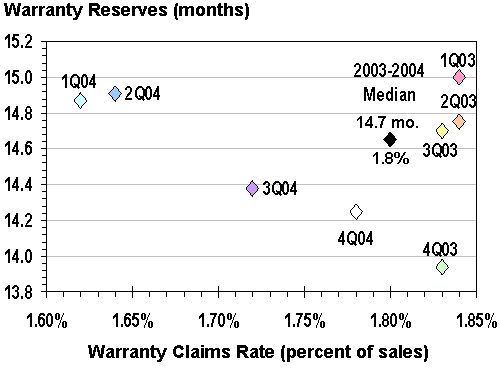Warranty Reserves:
How much is enough? Given a company's industry and the nature of its product warranties, how much should be kept in the warranty reserve fund? The funding decisions of 700 CFOs provide some insights.
American manufacturers ended 2004 with $37.25 billion in their warranty reserves, which at current claims rates would be enough to fund payments for the next 17 months. Is that enough? Or is it too much or too little?
Nobody knows better than a given company's chief financial officer whether a given amount is adequate. The CFO knows in detail the warranty claims history of each and every product line. The CFO knows how many products are in the field and how many are still under warranty, and the CFO can use past history to make very educated guesses concerning how many claims to expect in the future.
The best an outsider can do is to look at the public information of all manufacturers, which is averaged across all their product lines. All we get in their financial statements are net figures for the beginning and ending balance of the reserve fund, claims paid, accruals made, and any adjustments made because of foreign currency swings, acquisitions, or divestitures. Many times, those figures are rounded off to the nearest million.
So while the CFO of an automaker can probably predict the claims experience just for blue trucks in Montana with four-wheel drive, all an outsider can determine is the claims experience of all vehicles in all locations. So it is impossible for an outsider to say with certainty that a given amount of warranty reserves is adequate. And of course, one cannot say whether a prediction was correct until it's in the past tense.
Therefore, we need a different approach. We need the CFOs themselves to tell us how much they think is adequate. We don't need all the details of their methodologies. All we need is to see where they stand in respect to all the other CFOs in their industry.
Measuring Warranty Capacity
First we need to invent a new measure of capacity for the warranty reserve, because balances range from the thousands to the billions of dollars. So let's say a somewhat large manufacturer is reporting claims payments of $3 million per quarter, or $1 million per month. Let's say their warranty reserve fund balance at the end of a given quarter is $15 million. One could therefore say that the reserve fund has a capacity of 15 months -- meaning that it could pay for the next 15 months' worth of claims even if no further accruals were made. By the same measure, a small company paying out $2000 a month with $30,000 in the bank would be able to fund claims for 15 months. Then without any further accruals, the funds would be exhausted.
Of course, no company would cease making accruals, so that would never happen. And we're sure that no CFO would ever manipulate accruals or reserve fund balances in a way that artificially inflated or dampened earnings. Call us naïve, but we're going to take it as a given that the warranty reserve fund balance at any moment in time reflects exactly what the CFO believes is the precise amount needed to pay all future claims on products sold up to the present day. That should be the case whether there is a thousand or a billion dollars in the reserve fund.
If U.S.-based manufacturers had $37.25 billion in reserve as of Dec. 31 and if they paid $6.6 billion in claims during the fourth quarter of 2004, then at a rate of $2.2 billion per month those reserves would last them around 17 months. To be precise, the funds would last exactly 16.8 months at the rates seen at year's end.
Diving deeper, the capacity to pay claims would vary by company, by industry, by the average length of warranties, and by numerous other factors. For General Motors, their $9.1 billion in reserves would last them 22 months. That may be typical for an automotive OEM. Nortel Networks' $275 million would last them a little over 7 months. That may be typical for a telecom equipment manufacturer. Or maybe not.
Eight Quarters of Data
The first thing we did was to count up where all manufacturers stand. With eight quarters of warranty data in hand, and with useable data for between 651 and 718 companies during each of those quarters, we had available a total of 5,530 pairs of measurements of reserve fund balances and claims paid per month. It would be one thing to dump them all into a bucket and take a mathematical average, as was done above. It would be something else entirely to divide them into groups based upon where they stand in relation to each other.
If we take just an average, the results are going to be heavily weighted by companies such as GM, Ford Motor, Hewlett-Packard, Dell, General Electric, and United Technologies, which each keep a billion or more dollars in their reserve funds, and which each pay out more than a million dollars a day in claims. That's going to reflect the perspectives of six CFOs, not 700 or more. It would be better to find a way of ranking all 700-something CFOs.
Here's the theory: put 700 CFOs in a room, and ask them how much they really need in warranty reserves to fund future claims and protect their companies from sudden spikes. Whatever their answer, find the midpoint at which 350 are above and 350 are below that level. That would be the median -- the dividing line between the optimists and the pessimists. Half the CFOs believe they need more than the median to pay future claims, and half believe they can get away with less than the median.
During the first quarter of 2004, 713 manufacturers included in their financial statements all the needed details on their reserve fund balance and the net amount of claims paid. Reserve fund capacity ranged from one month to 858 months, and the one in the middle was 14.9 months. In the quarters before and since, the median has remained within a range of 13.9 to 15.0 months. Taking all 5,530 measurements at once, the median was 14.7 months.
Payments vs. Capacity to Pay
Let's add one more measurement to each of these figures and turn it into a graph. We can't measure installed base or the average length of warranties on products in the field. But we can measure claims rate, as a percentage of product revenue. Over the past eight quarters, the claims rate for all manufacturers has ranged from 1.62% to 1.84%. What follows is a graph where the vertical axis measures reserve fund capacity in months, and the horizontal axis measures claims rate in percent of product sales.
Warranty Reserves & Claims Rates
Eight Quarters, 2003-2004

Source: Warranty Week from SEC data
The eight colored diamonds represent the eight quarters of 2003 and 2004. We wish there were more data, but the rules which required manufacturers to disclose their warranty expenditures didn't take effect until the very end of 2002. So all we have are eight data points for the eight quarters, plus one data point (in black) for all eight quarters taken together.
As the graph shows, the midpoint at which half of all companies are above and half of all companies are below is 14.7 months. Interestingly, it's been higher in the first halves of the years and lower in the second halves, which we suspect is another manifestation of the "step function" seen in the quarterly claims totals. For whatever reason, companies typically spend more on warranty claims towards the end of the year than the beginning. And as this graph shows, they tend to let the capacity of their reserve funds fall towards the end of the year, only to bring it back up early in the next year (through increased accruals, decreased claims, or a little of both).
What's a Warranty Cost?
Unfortunately, there's no such thing as a typical manufacturer. We know claims rates vary tremendously, even within a single industry. We also know that no two manufacturers measure their warranty expenditures in quite the same way. For instance, some may set a value for parts used during a repair by their cost of manufacture. Others may measure them by the cost of replacing them. Still others may not consider the cost of parts to be a warranty expense. And then there's the cost of returning the broken parts. Is that a warranty expense? What if one company counts postage and freight as a warranty cost and another tells its service centers to discard the broken parts?
Between industries, there are massive differences in how labor costs are computed. With home computers, many manufacturers are now shipping parts directly to consumers and talking them through the self-repairs. Customer self-repairs are also common with truck and airplane fleets, but the customer usually bills the manufacturer for their time. With major appliances, manufacturers typically dispatch a repairman to the home, and discourage the consumer from doing much beyond checking to see if the plug is loose. With passenger cars, the vehicle is either driven, pushed, or towed to a service station, and attempts at self-repair are strongly discouraged.
Then there is the average duration of a warranty. With consumer electronics and increasingly with low-end computers, 90-day warranties are common. Passenger cars carry warranties of three to five years. Heating and air conditioning units can carry five, ten, or even fifteen year warranties. With some building materials such as metal roofing, 30-year warranties are not unheard of. Some tools and a few incredibly well-built products carry "lifetime" warranties. Clearly, the percentage of sales that should be placed into reserve would be different in each case.
So let's take a look at some industries. In fact, let's look at eight industries which together represented 85% of all claims paid during 2004. The question to be answered is whether typical reserve fund capacities vary by industry. As the chart below shows, they most certainly do.
Warranty Reserves & Claims Rates
Eight Industries Over Eight Quarters,
2003-2004

Source: Warranty Week from SEC data
For this chart, we took eight measurements for eight industries, resulting in 64 different pairings of claims rates and reserve fund capacities. Each industry is color coded and labeled. Some industries such as automotive OEMs are in a tight cluster. In their case, all eight data points are between 19 and 21 months and also between 2.4% and 2.7%. Draw a box around these data points and you have a pretty good rule of thumb for automakers. Anyone outside the box is unusual, and the further they are outside the box, the more unusual they are.
Building material manufacturers along with auto parts suppliers and aerospace/marine manufacturers also end up in tight clusters. Telecom equipment manufacturers show a bit more variance, and both semiconductor and appliance manufacturers seem to vary widely from one quarter to the next.
Computer manufacturers tend to keep their reserve fund capacities in a tight range of 10.8 to 13.1 months, but their claims rates vary between 3.1% and 3.8%, so their diffusion pattern is more horizontal. One could deduct that the CFOs in this business will typically adjust their reserve capacity carefully to match changes in claims rates. If the diffusion pattern was excessively vertical, one could say that claims rates are stable but the CFOs are out of control.
Besides the shapes of the groupings, it's also notable where they lie. As was previously mentioned, the midpoint for all manufacturers is 14.7 months and 1.8%. Therefore, the automotive OEMs are in the northeast quadrant, above the average both in terms of claims rate and reserve fund capacity. They tend to pay a higher than average percentage of their sales to honor claims, and their CFOs respond accordingly by maintaining a higher than average capacity in their reserve funds.
Conversely, manufacturers of building materials (and in most quarters also semiconductor manufacturers) tend to pay out a lower percentage of sales to honor claims. They also tend to keep relatively less on hand to pay future claims. In fact, one of the consistently lowest reserve fund capacities of all belongs to a carpet manufacturer who generally pays 1% of sales in claims and who generally keeps one month's worth of claims in reserve.
Sending a Mixed Message
Then there are all the CFOs who send a mixed message. In the computer industry, their claims are above average but their reserve fund capacities are below average. For instance, Sun Microsystems sees a claims rate of 4.8% and keeps 8.4 months' worth of funds in reserve. In the aerospace industry, their claims are lower but their reserve funds are larger. Boeing sees a claims rate of 1.2% but keeps 41 months in reserve.
Let's assume that each CFO has his or her reasons, whether it's the length of warranties, the cost of claims, or the likelihood of a sudden spike. In other words, let's assume that there are good reasons why different types of manufacturers cluster in different sectors. We don't know why, but let's again suggest that every CFO is doing what's best for his or her company.
One could therefore conclude that it's normal for the CFOs of aerospace manufacturers to reserve more than the CFOs of telecom equipment manufacturers or chip makers, even if their claims rates are identical. That's an important point. Boeing and Motorola are both around 1.2% in terms of claims rates, but Motorola reserves only 16 months to Boeing's 41. Cypress Semiconductor has a comparable claims rate of 1.1%, but its reserve fund capacity is under three months!
Likewise, it's normal for auto OEMs to reserve more than either computer or appliance OEMs, even if their claims rates are in the same general range of 2% to 4%. This is somewhat puzzling, because while it's obvious that OEMs generally suffer higher claims rates than their suppliers, it's unclear why the manufacturer of a refrigerator or a workstation would reserve relatively less than a carmaker. One could suggest the cost of product recalls or liability lawsuits as a possible factor, but those items are usually funded outside the warranty reserve.
Looking at the graph horizontally, it looks like it's normal for auto OEMs and auto parts manufacturers to reserve at similar capacity levels even if their claims rates are vastly different. In other words, if you're a CFO in the auto business, you're likely to feel comfortable with a reserve capacity of 15 to 25 months whether your claims rate is 0.4% or 4.0%. Higher reserve capacities may be typical of all auto manufacturers, no matter what their claims rates or their position within the supply chain.
With eight quarters of data now on hand, it's becoming easier and easier to determine what's "normal" for a given industry or even a given company. That's a necessary prerequisite for any type of early warning system. Before you can spot any deviance from the norm, you have to know what "normal" looks like.
| Back to Part Two |









